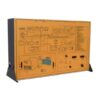OPERATION OF THE PLANT / TECHNICAL FEATURES
The unit includes the process plant and the cabinet where you can control all the elements involved. All elements of the plant are controlled from the lever switches in this cabinet. The plant includes two 125 liters tanks containing reagents that are sent into the column by two peristaltic pumps.
The column of the tubular chemical reactor is filled with water and it can be heated by recirculation of water in closed circuit to a tank equipped with an electrical resistance of 2500 W. This resistance must always operate submerged, and the water tank has a level sensor which prevents the operation of the resistance if the water level is not sufficient. The same heating system keeps the reactor at the desired temperature thanks to an external jacket of the reactor.
In the reaction tank of the chemical tubular reactor there is a silicone winding of 30 meters in length, and a useful volume of 2.3 liters that constitutes the tubular reactor properly said.
The reactants are driven by peristaltic pumps at a flow between 0 and 60 l/h, entering the column at its bottom through anti‐return valves and mixed immediately, and then mixing in the reactor and up to the top of column. Since the reactor is immersed in the heating water, during its travel the reactant mixture is maintained at the proper temperature for the reaction.
To view the inflow of both reactants, the system is provided with rotameters with maximum flow of 60 l/h. Likewise, by previously closing the inlet valves of the tubular chemical reactor, and opening the inlet to the stirred tank reactor, the reactants will enter in the reactor of 150 mm diameter and 500 mm height in which the reaction takes place; this reactor has an external heating system that allows maintaining the temperature at the desired value, likewise the reactant mixture is maintained under stirring by a variable speed stirrer.
In order to obtain that this temperature is reached already at the time of the mixture, in the heating water tank there are two stainless steel coils in which the reactants circulate before entering the reaction column for mixing.
The temperature regulation of the heating tank is carried out by a controller in the control cabinet. It can be seen at all times both the actual temperature in the tank and the fixed set point (desired temperature).
At the outlet of the tubular reactor there is a conductivity probe to measure this parameter in order to draw conclusions about the performed reaction; similarly, the stirred tank reactor has a conductivity probe placed inside the tank. Both displays are on the front panel of the cabinet.



















